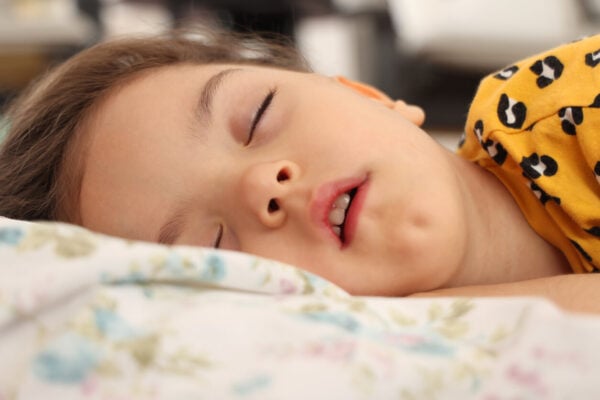
How to Dry A Mattress After Bedwetting
Here’s a straightforward guide to help you manage bedwetting clean-ups effectively, including tips for memory foam mattresses.

Bedwetting, also known as nocturnal enuresis, can persist well beyond the age of five, and one often-overlooked contributing factor is mouth breathing during sleep.
Many parents are surprised to learn there is research showing a link between mouth breathing and bed wetting, and that mouth breathing can even continue after tonsil or adenoid surgery. It is not the only cause, but it can be an important piece of the puzzle. When mouth breathing is addressed, many children experience better sleep and fewer wet nights.
If your child is between the ages of 5 and 12, still wetting the bed, and shows signs of mouth breathing, this article will help you understand how the two may be connected. We will look at how mouth breathing affects sleep and bladder control, why tongue posture matters, what you can try at home, and when it makes sense to get professional advice.
Mouth breathing might seem harmless, but over time it can disrupt deep sleep and reduce a child’s ability to wake and respond to a full bladder. When children sleep with their mouths open, they may:
A 2013 study by Khaleghipour and colleagues found that children with sleep-disordered breathing who practiced breathing retraining had fewer episodes of bedwetting, supporting the link between breathing and bladder control.
More recent research also shows that mouth breathing is closely linked to sleep-disordered breathing (SDB). A 2024 study of Indonesian children aged 8–9 found that 41% of mouth breathers showed signs of SDB, compared to just 9.7% of nasal breathers. This highlights how common breathing issues are in children, and how easily they can be overlooked. Poor sleep from mouth breathing doesn’t just affect bladder control; it can also leave children tired, less focused at school, and more irritable during the day.
Watch for these signs if you suspect your child may be mouth breathing:
Tongue posture means where the tongue rests when the mouth is closed. Ideally, it should sit against the roof of the mouth, just behind the front teeth. Many mouth breathers develop a low tongue posture, where the tongue rests at the bottom of the mouth. This can:
Therapies that retrain tongue posture, known as orofacial myofunctional therapy, have been shown to improve nasal breathing and, in some cases, reduce bedwetting linked to poor sleep and breathing.
Recent research also shows that children with adenoid problems and oral breathing can see improvements in jaw and dental development after only a few months of early treatment (Xie & Ma, 2025). This highlights why supporting good tongue posture and nasal breathing matters not only for sleep and bedwetting, but also for healthy facial growth.
Build communication between brain and bladder – Program to help build the messaging system between the brain and bladder.
Discover bedwetting triggers – Discover what encourages, triggers or causes bedwetting for your child. Set your child up for success!
Bed wetting help and support – Learn various techniques and tips to improve and reinforce bladder control.
Strengthen the muscles – Strengthen the 3 involuntary pelvic muscles and the ligaments they contract against to improve urge and bladder control
Guarantee – 90 day money back guarantee
Although nasal breathing is ideal, children sometimes resort to mouth breathing because of:
Mouth breathing can be a short-term solution, but if it becomes a habit, it may disrupt sleep and bladder control.
Both the nose and mouth provide a way to breathe, but they serve different functions.
Nose breathing:
Mouth breathing:
Here are some practical, non-invasive steps parents can try at home:
If your child continues to mouth breathe despite trying at-home steps, or if they experience symptoms such as chronic snoring, restless sleep, or ongoing nasal congestion, it may be time to consult a healthcare provider. Conditions like enlarged tonsils or adenoids, allergies, or dental issues can all contribute, and in some cases, surgery may be recommended. Learn more about how enlarged tonsils and adenoids affect bedwetting.
Yes. Even after tonsil or adenoid surgery, some children continue mouth breathing if tongue posture, nasal obstruction, or habits are not corrected. Surgery can clear the airway, but it does not always restore normal nasal breathing patterns.
A 2020 study in European Archives of Oto-Rhino-Laryngology found that children with risk factors such as older age, larger adenoids before surgery, or dentofacial abnormalities were significantly more likely to keep mouth breathing even after adenotonsillectomy. This shows why supporting healthy breathing habits afterwards is so important for long-term improvement.
Mouth breathing and bed wetting are often linked, but many families don’t realise how much of an impact breathing, sleep, and tongue posture can have. Supporting nasal breathing gently can lead to better sleep, more energy, and fewer wet nights.
If your child still wets the bed and shows signs of mouth breathing, these insights could make a real difference. The Stay Dry at Night program offers practical tools and guidance to help you address bedwetting causes step by step.

Ginny Laver BA (Hons), MSc, NLP, Dip. THP is a Clinical Hypnotherapist and Neuro Linguistic Programming (NLP) practitioner who specialises in helping children learn how to stop bedwetting naturally.
We’d love to hear from families who have seen changes in bedwetting when addressing mouth breathing. Sharing your experience can remind other parents that small changes can make a big difference.

Here’s a straightforward guide to help you manage bedwetting clean-ups effectively, including tips for memory foam mattresses.

This article delves deeper into the emotional and psychological triggers of bedwetting, providing parents with comprehensive insights and actionable strategies to support their children effectively.

Explore the role of hypnotherapy in treating bedwetting. Bedwetting hypnosis offers a gentle and effective alternative to stop bedwetting.
